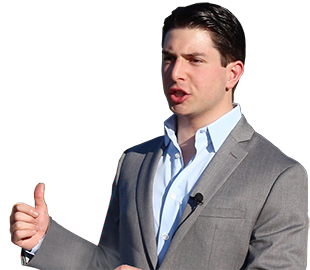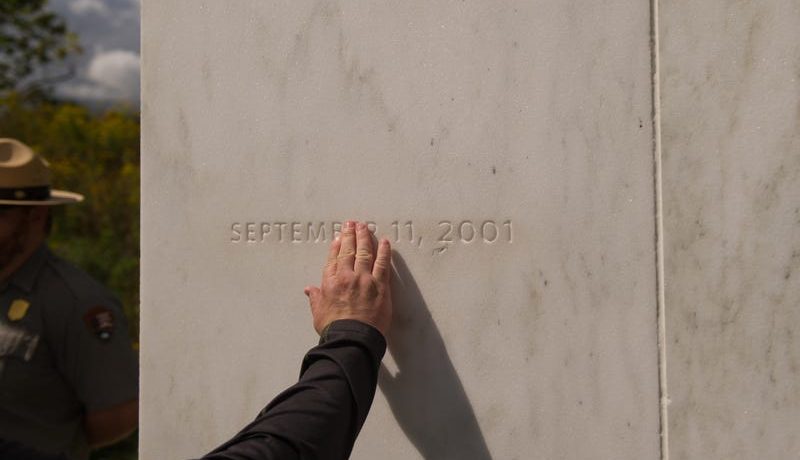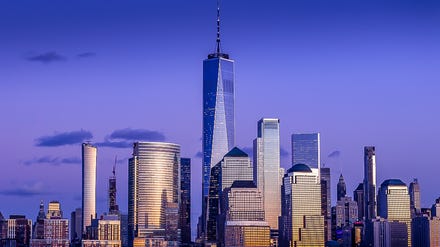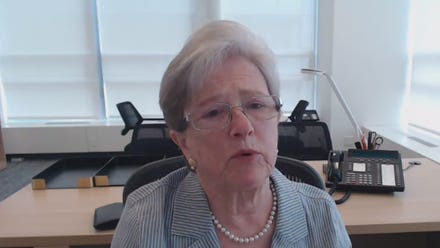
-
Commemorating 9/11: Never Forgotten 20 Years Later
Post Views: 671Produced by Neil A. Carousso
NEW YORK (WCBS 880) — At some point, everyone has seen or heard the heartbreaking news coverage of 9/11. Because all the reporters were so busy describing what they saw, it’s not often that they get to share what their personal experiences of the event were — until now.
This week, WCBS 880 has assembled four veteran journalists who worked and witnessed the attacks on the World Trade Center from varying angles that day.
Speaking with WCBS 880’s Wayne Cabot, former anchors Pat Carroll and Jeff Kaplan join reporters Sean Adams and Tom Kaminski to share each of their own real-time experiences, as well as their reflections since.
Despite seeing and processing everything differently, nothing was more important than the facts that day.
“All of your broadcast training, every breaking news story you ever covered in your whole life – suddenly you [realized] that it was preparing you for this moment,” Carroll says.
While nothing could ever prepare them for a tragedy of that caliber, Carroll adds, “We just went with it as though we had been preparing for this throughout our careers…[we knew] we were important. We were necessary.”
“It was absolutely impossible to comprehend the enormity of the situation,” Adams added. He was one of the street reporters closest to the towers that day, and witnessed the first building collapse.
He says he couldn’t believe what was happening, “because [it was] so much larger than anything [he’d] ever experienced before.”
https://omny.fm/shows/880-weekly-rewind/9-11-special-never-forgotten-20-years-laterHe also recalled telling himself, “Do not get killed,” that day because he couldn’t be of any use dead. With so much mayhem at the scene, it wasn’t until the South Tower collapsed that he was able to deliver his first live report.
As crucial as that report was to the people of New York, Adams revealed that the report meant something more to his family because it confirmed to them that he was still alive.
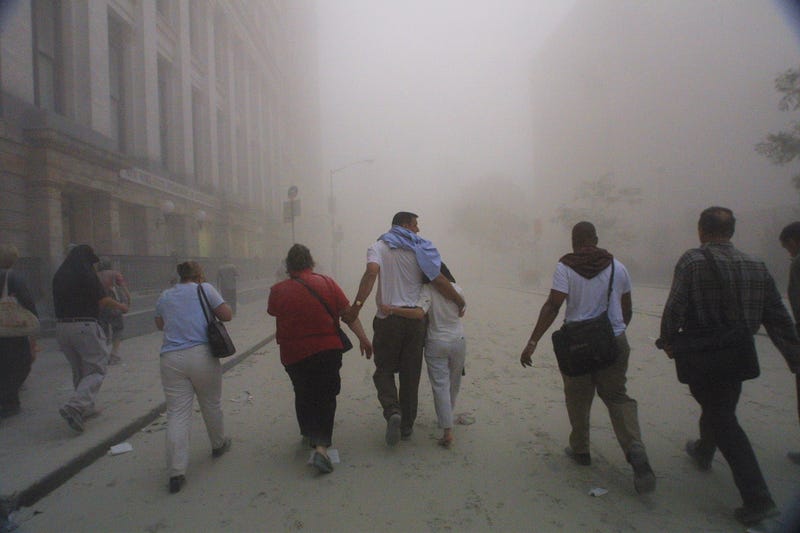
Civilians flee as a tower of the World Trade Center collapses September 11, 2001 after two airplanes slammed into the twin towers in an alleged terrorist attack. Photo credit (Photo by Mario Tama/Getty Images) Up in the sky that morning, Kaminski was just reporting traffic as usual when he saw what he called “the flash and the fireball” on the North Tower.
Even as Carroll patched him in to report what he was seeing, it wasn’t until he his pilot received word from air traffic controllers stating, “The airspace has been sterilized,” that they began to worry.
What scared them the most wasn’t the phrase itself, but rather the fact that as experienced as they were they had never heard it before. That’s when the seriousness of the situation started to settle in.
Kaminski continued to do his job until his helicopter was finally grounded. In fact, he points to one moment in the broadcast, right after the South Tower was struck, where you can hear him start talking about the traffic.
“I just needed to center myself,” he says, after realizing his hands started to shake.
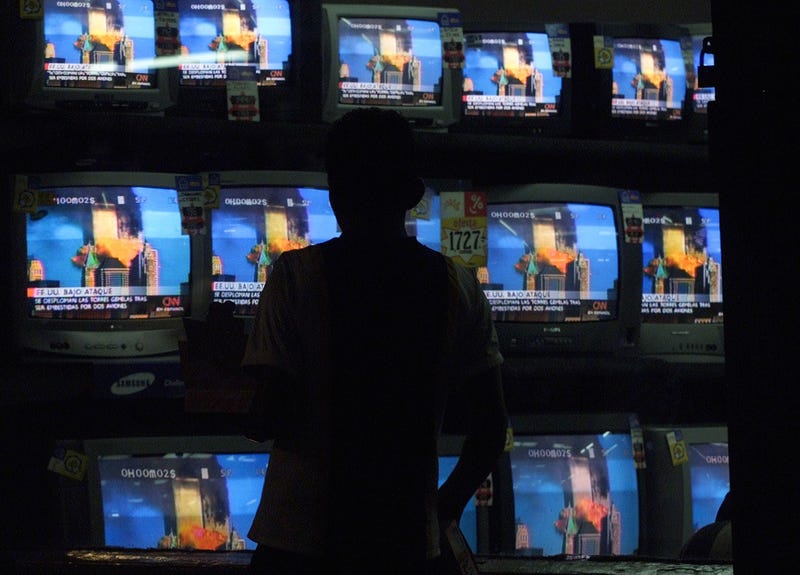
Guatemalan pedestrians watch on TV September 11, 2001 in Guatemala City, Guatemala the moment when a second plane commandeered by unknown hijackers slammed into New York’s World Trade Center. Photo credit (Photo by Andrea Nieto/Getty Images) “And doing traffic, which I had done for all these years, was exactly how I did that,” he continued, “I start talking about traffic on West Street, and on Canal Street, and I talked about vehicles coming down into [that] area from every conceivable direction. That was for me.”Guatemalan pedestrians watch on TV September 11, 2001 in Guatemala City, Guatemala the moment when a second plane commandeered by unknown hijackers slammed into New York’s World Trade Center. Photo credit (Photo by Andrea Nieto/Getty Images)
When he didn’t know what else to do, Kaminski just did his job. Looking back on that day, former 880 anchor Jeff Kaplan agrees that every reporter that day was “on autopilot.”
He recalls watching a random 9/11 special on TV one year where the entire day was synched up to pictures, video, and audio. It wasn’t until he saw people “gathering around somebody’s radio, holding hands [listening to] our voices…listening with tears coming down their faces,” he wasn’t aware of how much 880’s coverage – or any coverage – meant to the average listener that day.
He says that seeing, “the way that people perceived what [they] were doing,” made him lose it.
See WCBS Newsradio 880’s 9/11 anniversary coverage here.
-
‘Hope, Resiliency, and Strength:’ Lasting Message of WTC Site 20 Years after 9/11
Post Views: 661By Joe Connolly and Neil A. Carousso
NEW YORK (WCBS 880) — The World Trade Center site is a living, breathing memorial of the people lost in the September 11 terrorist attacks, a bustling business district and architectural wonder that stands tall as a sign of freedom and New York’s resilience in recovering from the fateful tragedy.
“I think there is a responsibility that whatever sadness and tragedy has befallen a place, at the end, there needs to be a message of hope, resilience and strength,” said architect Daniel Libeskind on the WCBS Small Business Spotlight, sponsored by Dime Community Bank.
The tear-jerking reflecting pools, the breathtaking Freedom Tower, and the awe-inspiring Oculus Transportation Hub were all part of Libeskind’s master plan to revitalize the site after 9/11.
“That’s what the spirit of humanity is. It’s not just to give in to the irretrievable and irreversible past. It’s to show that we can overcome it; we will not forget it,” he said.
Libeskind is a world-famous architect whose designs include the Jewish Museum Berlin and hundreds of modern buildings enjoyed by millions around the world from the United States to Europe and beyond. He was born and raised in Poland to Holocaust survivors and was among the last to immigrate to New York by boat into Ellis Island.
“You have to be a lucky man to be living in New York to be able to take the subway or walk somewhere into a corner of New York that is maybe 10 blocks away from you but it’s a different New York,” he said, continuing, “That’s the beauty of New York. You move a few blocks and you’re in a different neighborhood. New York is really a kaleidoscope of diversity.”
Libeskind told Joe Connolly and Neil A. Carousso that exploring and experiencing the city is a quintessential act for himself as an architect, but said it can be inspiring for anyone. Attracted to the energy of New York City, he is confident the offices at the World Trade Center will be at full capacity again after the COVID-19 pandemic, because while working from home is convenient, he believes the collaborative and creative work that can be achieved in the social space of the office is unmatched.
“There’s no doubt that offices will continue to play a key role and I really know it from my own office, which is in Lower Manhattan, that it’s so inspiring to have people back in the office, seeing each other, working together. It’s irreplaceable. You can never do it from your home that way,” Libeskind said.
He noted many offices are being reconstructed to meet the new pandemic demands of distance and ventilation and supports converting empty offices into residential buildings.
“When we were building Ground Zero, many of the great office buildings, which were already modern office buildings, were being converted to residential buildings and that has brought a lot of life to Lower Manhattan,” said Libeskind, hopeful that doing so now will improve the city’s affordability.
He told WCBS 880 he has been working on designing modern New York City Housing Authority (NYCHA) buildings for elderly residents in Brooklyn and Long Island City and believes introducing quality architecture and greater living space will attract new, talented people to live and work in New York.
Watch Joe Connolly and Neil A. Carousso’s conversation with world-famous architect Daniel Libeskind for a reflection on the World Trade Center revitalization and discussion about New York City’s post-pandemic future on the WCBS Small Business Spotlight video above.
-
Hurricane Ida Causes Deadly Flooding and Widespread Devastation from Louisiana to New York; Afghanistan War Ends but Americans are Left Behind
Post Views: 501Produced by Neil A. Carousso
NEW YORK (WCBS 880) — Hurricane Ida caused deadly flooding in the Northeast Wednesday night into Thursday with widespread damage and road closures lasting past Friday.
https://omny.fm/shows/880-weekly-rewind/hurricane-ida-causes-deadly-flooding-and-widespreaLynda Lopez anchors team coverage from across the Tri-State on The 880 Weekly Rewind and checks in on the devastation in Louisiana where residents could remain without power into a second week after Ida made landfall Sunday as a category 4 hurricane.
Plus, producer Neil A. Carousso talked to Dion Nissenbaum who covers U.S. Middle East policy for The Wall Street Journal about the hundreds of Americans and thousands of Afghan allies left behind after United States troops completed their withdrawal from Afghanistan on Monday, including an Afghan interpreter who helped rescue then-Sen. Joe Biden in 2008.
Subscribe and download The 880 Weekly Rewind podcast for in-depth reporting and deeper analysis of the top stories of the week, produced by Neil A. Carousso, for WCBS-AM New York.
-
NY Business Leader on Why Pandemic Recovery is More Complex than 9/11
Post Views: 736By Joe Connolly and Neil A. Carousso
NEW YORK (WCBS 880) — Kathryn S. Wylde has been president of the Partnership for New York City since 2001, thrust into the devastation of 9/11 and the business recovery effort when fear of another terrorist attack clouded whether Manhattan would ever come back.
Wylde hosted strategy sessions with then-Governor George Pataki and Sens. Charles Schumer and Hillary Clinton at the Partnership’s Downtown offices in the aftermath. But, she told Joe Connolly and Neil A. Carousso on the WCBS Small Business Spotlight, sponsored by Dime Community Bank, that the economic issues were more clear 20 years ago compared to the complexity of the COVID-19 pandemic.
“We were able to be ready for recovery by January,” she said. “We hosted the Davos World Economic Forum at the Waldorf and had thousands of notable leaders of countries and businesses from around the world flying into New York.”
International travel is still not fully open. The city’s offices were not open at 100 percent until June 15, 2021 – 15 months after the coronavirus forced large-scale shutdowns to control the spread of the disease.
Wylde says New York has suffered immeasurable financial losses as a result of the pandemic.
“On 9/11, we had the temporary displacement of 3,000 small businesses and we lost about 130,000 jobs – most of which were recovered completely within a year and a half/two years. Today, we’re down 462,000 jobs and we don’t know how many of those are going to come back,” the business leader said.
She told WCBS 880 that small businesses in retail and hospitality may never be the same. But, there has been record venture capital investments in new professional services companies that are catering to pandemic needs. Their biggest challenge, Wylde said, is competing for workers.
The Partnership for New York City lists 387,000 open job postings. With a tight labor market and a work from home environment, hiring skilled workers remains a major hurdle this fall.
“Today, we’re economically, at a macro level, in better shape, but the implications of this whole remote work situation and what’s happened to our brick-and-mortar economy – the small businesses – which are 9 percent of the economy but they’re 20 percent of the jobs – we don’t know how much of those are coming back – both the businesses or the jobs. We don’t really know the damage caused a year and a half into this,” Wylde said, noting large businesses are better positioned for the post-pandemic economy because they amass greater resources.
She is concerned emerging variants of COVD-19 that are more transmissible and more contagious, and potentially could weaken vaccine efficacy, might require new shutdowns that could wipe out some sectors.
Despite the widescale problems, Wylde remains optimistic about New York’s recovery. When asked how she keeps going, she told Connolly and Carousso she is encouraged that communities have come together, which she said is reminiscent of the 1970s and early 1980s when the city was faced with a fiscal crisis that ignited a seismic shift from mostly industrial work to a service economy.
“The same thing I’ve seen happening while government was focused full bore on the health crisis, communities came together to support each other, and to provide services, and to make sure neighbors had groceries, and that the elderly had visitors, and that the health care workers were applauded with pots and pans as they were going off to save lives,” Wylde explained. “I’ve seen communities come together in a way that demonstrates the strength and resilience of New York.”
Watch Joe Connolly and Neil A. Carousso’s full conversation with Kathryn Wylde on the Small Business Spotlight video above.
-
WCBS 880 Weekly Rewind: Afghanistan Evacuation Turns Deadly, China Blames the U.S. for COVID, Kathy Hochul Takes the Reigns of New York
Post Views: 569Produced by Neil A. Carousso
NEW YORK (WCBS 880) — U.S. forces pressed ahead with evacuation efforts of American citizens and Afghan allies Friday, a day after an ISIS suicide bomber killed 13 United States service members and hundreds of Afghans and under threats of more attacks. President Joe Biden is sticking to the Tuesday deadline to withdraw all troops from Afghanistan.
https://omny.fm/shows/880-weekly-rewind/afghanistan-evacuation-turns-deadly-china-blames-tWCBS anchor Steve Scott filled in for Lynda Lopez on The 880 Weekly Rewind and examined the urgent evacuations in Kabul with CBS News Military Consultant and Retired Army Col. Jeff McCausland.
WCBS’ Paul Murnane looked into the “inconclusive” report on the origins of the coronavirus with CBS News Asia Correspondent Ramy Inocencio who has been reporting in Wuhan and Hong Kong on how China has flipped the script on the United States, blaming the U.S. for the virus without evidence.
In New York, history was made as Gov. Kathy Hochul became the first female executive in the state. She hit the ground running with a series of COVID-related policies, including masks and vaccinations in schools and promising to get federal relief funds to landlords, which had been stalled under her predecessor Andrew Cuomo’s administration. Hochul also vowed to be transparent and acknowledged nearly 12,000 more deaths due to COVID-19 than Cuomo said publicly.
Subscribe and download The 880 Weekly Rewind podcast for in-depth reporting and deeper analysis of the top stories of the week, produced by Neil A. Carousso, for WCBS-AM New York.
The World
Social Feeds

VIDEO: Told the airline to book us on the next flight out (SPONTANEOUS TRIP!)

VIDEO: The Taylor Swift Effect | WCBS Business Breakfast

VIDEO: Future of NYC | WCBS Business Breakfast

VIDEO: Reasons for New Yorkers to be Optimistic | WCBS Business Breakfast

VIDEO: NYC's AI Chatbot | WCBS Business Breakfast

